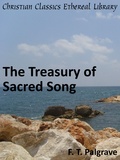Francis T. Palgrave
English critic and poet
Biography
Francis Turner Palgrave was the eldest son of Sir Francis Palgrave, the historian, born at Great Yarmouth, on the 28th of September 1824. His childhood was spent at Yarmouth and at his father's house in Hampstead. At fourteen he was sent as a day student to Charterhouse; and in 1843, having in the meanwhile travelled extensively in Italy and other parts of the continent, he proceeded to Oxford, having won a scholarship at Balliol. In 1846 he interrupted his university career to serve as assistant private secretary to Gladstone, but returned to Oxford the next year, and took a first class in Literae Humaniores. From 1847 to 1862 he was fellow of Exeter College, and in 1849 entered the Education Department at Whitehall.
In 1850 he accepted the vice-principalship of Kneller Hall Training College at Twickenham.There he came into contact with Alfred Lord Tennyson, and laid the foundation of a lifelong friendship. When the training college was abandoned, Palgrave returned to Whitehall in 1855, becoming examiner in the Education Department, and eventually assistant secretary. He married, in 1862, Cecil Grenville Milnes, daughter of James Milnes-Gaskell. In 1884 he resigned his position at the Education Department, and in the following year succeeded John Campbell Shairp as professor of poetry at Oxford. He died in London on the 24th of October 1897, and was buried in the cemetery on Barnes Common.
Palgrave published both criticism and poetry, but his work as a critic was by far the more important. His Visions of England (1880-81) has dignity and lucidity, but little of the "natural magic" which the greatest of his predecessors in the Oxford chair considered rightly to be the test of inspiration. His last volume of poetry, Amenophis, appeared in 1892. On the other hand, his criticism was always marked by fine and sensitive tact, quick intuitive perception, and generally sound judgment. His Handbook to the Fine Arts Collection, International Exhibition, 1862, and his Essays on Art (1866), though not free from dogmatism and overemphasis, were sincere contributions to art criticism, full of striking judgments strikingly expressed. His Landscape in Poetry (1897) showed wide knowledge and critical appreciation of one of the most attractive aspects of poetic interpretation.
But Palgrave's principal contribution to the development of literary taste was contained in his Golden Treasury of English Songs and Lyrics (1861), an anthology of the best poetry in the language constructed upon a plan sound and spacious, and followed out with a delicacy of feeling which could scarcely be surpassed. Palgrave followed it with a Treasury of Sacred Song (1889), and a second series of the Golden Treasury (1897), including the work of later poets, but in neither of these was quite the same exquisiteness of judgment preserved. Among his other works were The Passionate Pilgrim (1858), a volume of selections from Robert Herrick entitled Chrysomela (1877), a memoir of Arthur Hugh Clough (1862) and a critical essay on Scott (1866) prefixed to an edition of his poems.

